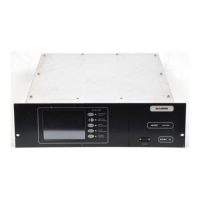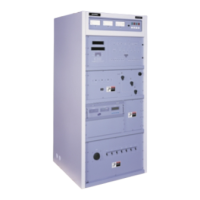SECTION A
OSCILLATOR (A16)
A.1. Principles Of Operation
The oscillator is the frequency determin-
ing source. The crystal oscillator stage is a
voltage stabilizedPiercecircuitoperatingat
2 or 4 times the carrier frequency. The crys-
tal operates in its parallel resonant mode
and meets FCC requirements.
For carrier frequencies of 1250 kHz and
below, the crystal operates at 4 times the
carrier frequency, and for carrier frequen-
cies above 1250 kHz the crystal operates at
2 times the carrier frequency.
Buffer/squaring amplifier Q2 is lightly
coupled to the oscillator and provides a 5
volt square wave to the programmable di-
viderU1.Thisdividerwilldividethecrystal
frequency by 2 or 4 to obtain the carrier
frequency.
Thedividerdrivesa levelshifterU2which
produces a 15 volt square wave. This stage
drives the class D output transistor pair Q3
and Q4 which produce about 2 watts of RF
drive to the IPA.
Regulator U3 supplies about16 volt to the
Q3/Q4 output stage.
Q6 and Q5comprise RF drive kill circuits.
When the transmitter is shut off in the Re-
mote mode, the RF drive is muted via the
RF Kill input to the Oscillator board.
A.2. Replacement/Alignment
A.2.1. Frequency Adjustment
A16C1 trims the carrier frequency at least
+/-20 Hz. This should only be adjusted ac-
cording to a frequency monitoring instru-
ment or service.
A.3. Troubleshooting the
RF Oscillator
A.3.1. Symptom: No Output
Possible causes:
A.3.1.1. Open Fuse/Loss of +20V
Check the dc voltage on each side of F1.
20 volts should be present anytime AC
power is supplied to the transmitter and the
low voltage circuit breaker is set to ON.
A.3.1.2. RF KILL
The Controller may be sending an RF
KILL signal to the oscillator. Check the
voltage at the inputside ofR16.This should
be about5 volts for theoscillatorto produce
RF. If the voltage at R16 is near zero, then
check the RF KILL signal output of the
Controller board.
A.3.1.3. Q1,Q2,CR1
Using an oscilloscope, check the signals
at Q1 and Q2 per the schematic. Frequency
of the signals at Q1 and Q2 should be 2 or
4 times the carrier frequency, depending on
thejumperwire arrangementatE3-E6.CR1
sets the supply voltage for Q1 and Q2 to 15
volts.
A.3.1.4. U1,CR4
The output of U1 at E6 should be a 4-5
volt peak to peak square wave at the carrier
frequency. The RF drive mutingcircuit util-
izes the voltage at U1-2 to gate U1 on and
off. During a normal on condition, U1-2
should be high (+5 volts). CR4 sets the
supply voltage for U1 to be 5.1 volts.
A.3.1.5. U2
U2 should provide a voltage level shift
from5voltspeak-to-peakatpin2to15volts
peak-to-peak at pin 7. Both signals should
be square waves.
A.3.1.6. U3
U3 supplies about 16 volts to Q3 and Q4.
Check thevoltage atthe collectorof Q3.U3
may be openif no voltage issupplied to Q3.
Figure A-1
Oscillator Board Output, 16Vp-p
Figure A-2
Upper Trace - Q1-C, 8-12Vp-p
Lower Trace - Q2-C, 4-6Vp-p
Rev. AE: 03-05-2002 888-2314-001 A-1
WARNING: Disconnect primary power prior to servicing.
